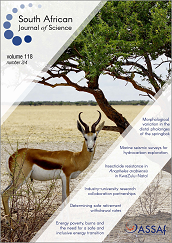Impact of land-use changes on ant communities and the retention of ecosystem services in Rashad District, Southern Kordofan, Sudan
DOI:
https://doi.org/10.17159/sajs.2022/11994Keywords:
biodiversity, disturbance, richness, savanna, Rashad District, SudanAbstract
The ecological consequences of biodiversity loss are usually the reduction of ecosystem functions. These responses, however, differ depending on the type of land-use change and the ecological setting. We investigated the impact of land-use type and ecosystem functions on the ant assemblage of Rashad District, Sudan. We analysed the effects of three different land uses (soy monoculture, pasture and organic production of vegetables) on the ant community by assessing ant composition in 176 different locations. The collection sites were conventional soy monoculture, pastures, organic agriculture, and native vegetation such as Campo, Kubos, and forests. We recorded 264 ant species on the soil surface of the Rashad District, where 342 to 354 species were thought to exist. Pastures and organic agriculture areas have 61% and 56% of the native myrmecofauna, respectively, while conventional soy monoculture areas are home to only 17% of native ant species. Forest areas present a unique community, and soy monoculture areas have the strongest pattern of biotic homogenisation. We also detected that rare species (of low frequency) were the chief promoters of richness in the Rashad District, and the most threatened with local extinction, due to their low density and low occurrence in agrosystems. Overall, we found that agricultural expansion reduces ant diversity, particularly in soybean crops, and can affect ecosystem functions. To mitigate the reduction in the ant assemblage, we recommend the conservation of multiple natural habitats.
Significance:
- Agricultural land conversion and climate change play a major role in shaping tropical landscapes, but the direct and indirect links to biodiversity and species community composition remain poorly understood.
- Ant richness is correlated with biomass, demonstrating that the effects on ecosystem function are dependent on the particularities of each assessed function (such as resource type), the types of land uses, and the abundance of ants in the region.
- Land-use effects on ant diversity were strongly scale dependent.
- The highest ant diversity occurred in soy monoculture areas.
Downloads
Published
Issue
Section
License

All articles are published under a Creative Commons Attribution 4.0 International Licence
Copyright is retained by the authors. Readers are welcome to reproduce, share and adapt the content without permission provided the source is attributed.
Disclaimer: The publisher and editors accept no responsibility for statements made by the authors
How to Cite
- Abstract 775
- PDF 998
- EPUB 557
- XML 550
- Supplementary material 154












.png)